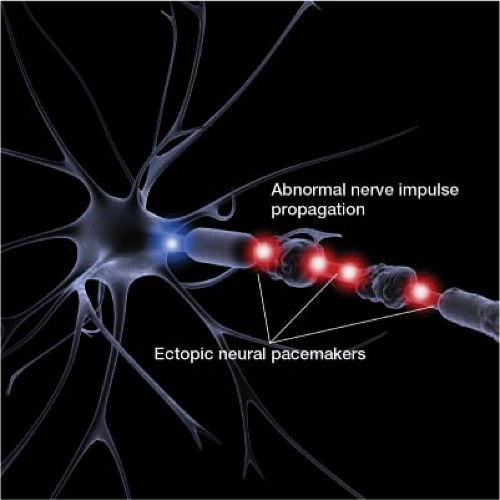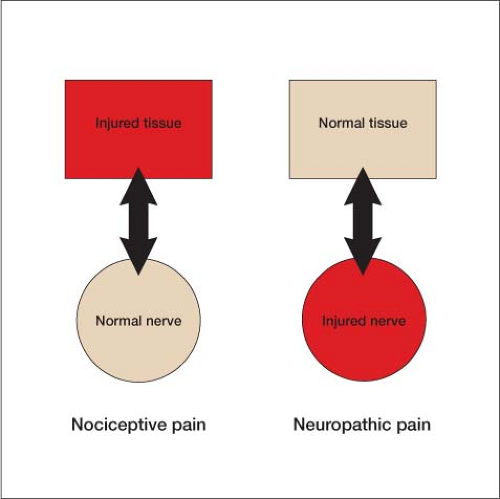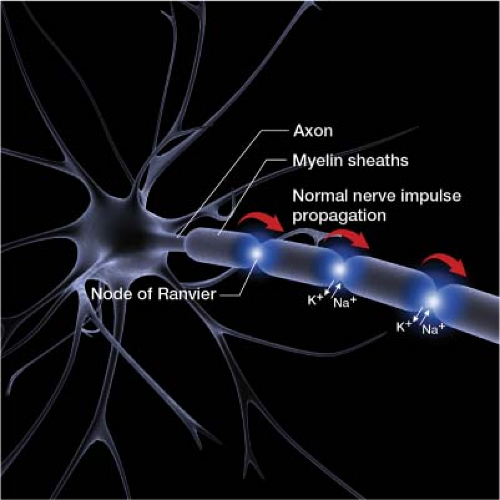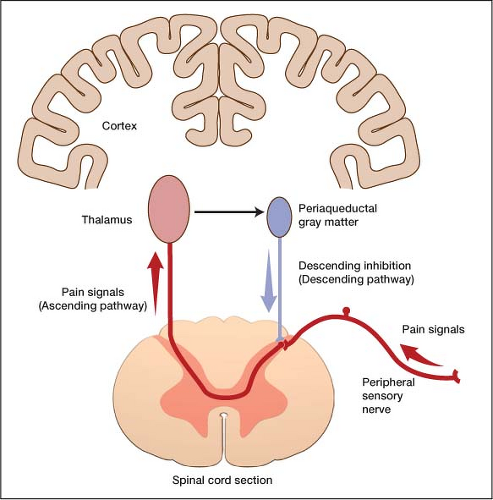Antidepressant Medications Used for Neuropathic Pain
Pain is transmitted through the nervous system. There are two main types of pain. Nociceptive pain and Neuropathic pain. Nociceptive pain is the natural consequence of tissue injury. Sensation from damaged tissue transmitted along well-functioning, healthy nerves to the brain for interpretation. An example of this is arthritis. The brain senses nociceptive pain as a sharp or achy type of pain.
In contrast, neuropathic pain involves nerve damage. When the nerves themselves become damaged, rather than their surrounding tissue (Fig. 13-1). Damaged nerves fire aberrantly and without provocation. A common example of neuropathic pain is diabetic peripheral neuropathy. The brain senses neuropathic pain as a burning, electric, tingling type of pain.
A stimulus with sufficient strength triggers the start of a neurotransmission. On a grand scale the impulses travel along the neural pathways from a small peripheral nerve, to a larger more centralized nerve, to the spinal cord, and then up to the brain for interpretation. At a local level a stimulus above the minimal threshold
triggers the dendrites of a nerve to internalize the signal, propagate that action potential, in a well-controlled manner, along the axon as sodium rushes in and potassium rushes out between the nodes of Ranvier. Finally the nerve releases, via a calcium controlled–channel system, neurotransmitters across the synaptic cleft at the axon terminal to pass on the impulse on to the next nerve (Fig. 13-2). With nerve damage, ectopic neuronal pacemakers can form at various sites along the length of an injured nerve. In addition, there is an increased response to stimuli that would not normally be painful (Fig. 13-3).
triggers the dendrites of a nerve to internalize the signal, propagate that action potential, in a well-controlled manner, along the axon as sodium rushes in and potassium rushes out between the nodes of Ranvier. Finally the nerve releases, via a calcium controlled–channel system, neurotransmitters across the synaptic cleft at the axon terminal to pass on the impulse on to the next nerve (Fig. 13-2). With nerve damage, ectopic neuronal pacemakers can form at various sites along the length of an injured nerve. In addition, there is an increased response to stimuli that would not normally be painful (Fig. 13-3).
The use of certain antidepressant medication for neuropathic pain occurred as the result of clinical observation. Patients were reporting back to their doctors that although the antidepressant medication may or may not have helped their depression, it reduced the burning pain in their feet. Doctors began to take note that a few of the antidepressant medications worked particularly well for their patients’ neuropathy. At first, it was theorized that the antidepressants most likely helped with depression and pain reduction was a consequence of this. Then it was observed that the response occurred only with particular antidepressants and seemed to work irrespective of the drugs’ effects on depression.1 Further evidence showed that the antidepressants that worked on pain were found to work more rapidly on pain than depression and at doses significantly lower than have been shown to be therapeutic for depression.
The tricyclic antidepressants (TCAs), which work by blocking the reuptake of norepinephrine and serotonin, were one of the first antidepressant medications found to be particularly helpful for neuropathic pain. The mechanism of action of TCAs in the prevention of neuropathic pain is not known. TCAs are divided into two classes: Tertiary amines and secondary amines. The tertiary amines typically work better but have a higher propensity for side effects. The two most commonly prescribed TCAs are amitriptyline (Elavil), a tertiary amine, and nortriptyline (Pamelor), a secondary amine.
 Figure 13-3 Ectopic neuronal pacemakers forming at various sites along the length of an injured nerve. |
Antidepressants that block both norepinephrine and serotonin, such as TCAs, can work well for neuropathic pain. Selective serotonin reuptake inhibitors (SSRIs) are not recommended for neuropathic pain.2 In clinical trials, the efficacy of SSRIs for treating neuropathic pain in humans has been inconsistent.3 SSRIs including Sertraline (Zoloft), Paroxetine (Paxil), and Fluoxetine (Prozac) are not recommended for the treatment of neuropathic pain.
Duloxetine (Cymbalta) is a serotonin and norepinephrine transport inhibitor. It is relatively balanced in its capacity for both serotonin and norepinephrine reuptake inhibition. Its method of action in pain relief is not known, but it is thought to modulate the descending inhibitory pain pathway in the brain and spinal cord, facilitating an endogenous analgesic mechanism. Pain messages travel like two-way traffic. One pathway, the ascending pathway sends the message to the brain whereas the other pathway, descending pathway, modulates its strength (Fig. 13-4). In 2004, the Food and Drug Administration (FDA) approved duloxetine (cymbalta) for the treatment
of diabetic peripheral neuropathy. It is a treatment for the same types of neuropathic pain for which TCAs are used.
of diabetic peripheral neuropathy. It is a treatment for the same types of neuropathic pain for which TCAs are used.
When to use
Neuropathic Pain
Nerve damage may occur in several ways. Uncontrolled diabetes, HIV, or alcohol abuse commonly injures distal peripheral nerves. The rate of diabetes, and thus diabetic peripheral neuropathy, in the United States is growing rapidly. One study looked at the rate of neuropathy in patients with newly diagnosed noninsulin-dependent diabetes who were followed for 10 years. On diagnosis, 8.3% of patients had neuropathy; at 10 years the rate of neuropathy grew to 41.9%.4 Nerves can also be damaged by medications, such as ethambutol, which is used to treat tuberculosis. Nerves can be entrapped, such as in carpal tunnel syndrome, as well as entrapped by a herniated disc, such as in cervical and lumbar radiculopathy. Other common neuropathies include postherpetic neuralgia, trigeminal neuralgia, intercostal neuralgia, and stump neuromas. Sometimes a definitive diagnosis is not possible, but if the patient describes the pain as electric and burning in nature it is reasonable to try a neuropathic pain medication.

Full access? Get Clinical Tree











